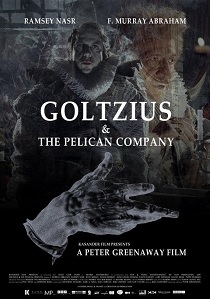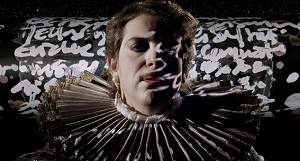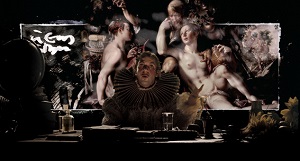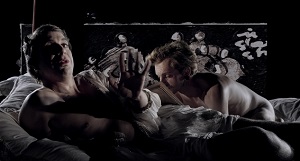 What the hell, man? To be fair, for over thirty years director Peter Greenaway has been shooting off-beat films that make David Lynch’s weirdest shit look like an episode of Friends, yet that’s hardly an excuse for Goltzius and the Pelican Company. A nauseating exercise in cinematic expressionism, the film will probably enchant the handful of Greenaway fans out there that delight in the man’s prepubescent madness, yet will likely frustrate and disgust people expecting a sensible, coherent movie.
What the hell, man? To be fair, for over thirty years director Peter Greenaway has been shooting off-beat films that make David Lynch’s weirdest shit look like an episode of Friends, yet that’s hardly an excuse for Goltzius and the Pelican Company. A nauseating exercise in cinematic expressionism, the film will probably enchant the handful of Greenaway fans out there that delight in the man’s prepubescent madness, yet will likely frustrate and disgust people expecting a sensible, coherent movie.
The film is ostensibly about Goltzius (Ramsey Nasr), a 16th century Dutch engraver and jack-of-all-trades artist who is shopping for a noble patron. Goltzius and his troupe of artisans, the Pelican Company, come to the estate of The Margrave (F. Murray Abraham), who they hope will bankroll their next venture. Goltzius and his Pelican Company propose to manufacture sexually explicit stroke-books depicting the naughtiest scenes from Biblical and Greek literature, yet need The Margrave’s cash for a printing press. Although The Margrave is reluctant to provide the money for the little porn venture, he does agree to give Goltzuis a week to prove how popular this all could be by putting on a series of stage plays depicting the proposed work.
Thus begins the increasingly explicit descent into Biblical debauchery, for as Goltzius narrates the action for the audience, his Pelican Company acts out the naughtiest, most naked moments from God’s good book. As interesting and mildly amusing as this is for the first couple of minutes, the sheen quickly wears off, and leaves nothing but the half-assed attempts Greenaway makes at tying his movie’s stories-within-a-story to the conceit of the film’s own P.O.V. For example, it doesn’t take long for the lines between the picture’s fiction to begin to blur with the Biblical stories of the Pelican Company, like when The Margrave lustfully spies another man’s mistress taking a bath (a-la David and Bathsheba).
 As Goltzius explains in his omniscient narration, the stories all represent a take on a carnal vice perpetrated by one of the Bible’s principle heroes, be it voyeurism, pedophilia, incest, etc. The scenes act as a critique of established morality standards, and the rule of law itself: intertwined as that institution was with Church dogma during that time and place. The Margrave and his supposedly free-speech Court claim to be paragons of morality, like the Bible, thus Goltzius’ productions play up this hypocritical association in his troupe’s work.
As Goltzius explains in his omniscient narration, the stories all represent a take on a carnal vice perpetrated by one of the Bible’s principle heroes, be it voyeurism, pedophilia, incest, etc. The scenes act as a critique of established morality standards, and the rule of law itself: intertwined as that institution was with Church dogma during that time and place. The Margrave and his supposedly free-speech Court claim to be paragons of morality, like the Bible, thus Goltzius’ productions play up this hypocritical association in his troupe’s work.
Naturally, it doesn’t take long for The Margrave to pull the plug on all of this, or at least try to, for the associations Goltzius draws are clear enough for anyone to see. Although he’s got a magnanimous reputation to uphold, The Margrave isn’t about to let some touring gaggle of artistic vagabonds disrupt peace in his Court: free speech be damned. It’s an interesting melding of perspectives and thematic cross-cutting, yet Greenaway’s apparent dick-worship and tit fetishes repeatedly get in the way.
 This is the second film in Greenaway’s “Dutch Masters” series, and the thematic connections to Renaissance art are one of the visual staples of Goltzius and the Pelican Company. As is the case with so much of the director’s work, nudity abounds in this movie, and becomes such a stable element that one almost stops noticing the presence of a fully exposed dick in nearly every scene (the key word there being “almost”). The fact that Goltzius is performing scenes from the Bible is also a very deliberate synthesis of Greenaway’s broader thematic arc, for these scenes repeatedly appear in the paintings of the Renaissance artists the director is trying to weave into his own work.
This is the second film in Greenaway’s “Dutch Masters” series, and the thematic connections to Renaissance art are one of the visual staples of Goltzius and the Pelican Company. As is the case with so much of the director’s work, nudity abounds in this movie, and becomes such a stable element that one almost stops noticing the presence of a fully exposed dick in nearly every scene (the key word there being “almost”). The fact that Goltzius is performing scenes from the Bible is also a very deliberate synthesis of Greenaway’s broader thematic arc, for these scenes repeatedly appear in the paintings of the Renaissance artists the director is trying to weave into his own work.
Yet that seems to be about as deep as this one goes, because aside from these inter-genre dalliances, the film is little more than two hours of exploitative pseudo-porn that feels like a John Waters movie on P.C.P. Again, all of this seems to be very much the point, for Goltzius and the Pelican Company hardly seems like a misfire for Greenaway. No, quite the opposite: this newest offering from the director is precisely what one might expect from the provocative iconoclast. Yet that doesn’t make the film any more enjoyable, for at 120 minutes, the repetitive nature of the dizzying narrative grows stale and increasingly translucent in less than half that time.
 None of the film’s characters possess anything that could be mistaken for depth: something that has the unfortunate effect of allowing for little to no investment in the story. Indeed, it’s often hard to discern who is who, something that only further confounds a viewer constantly trying to understand just what the hell is going on half the time. Anachronisms abound, as in the David and Bathsheba scene, where light fixtures are clearly visible at the top of the shot’s frame; it’s hard to know whether these modern flourishes are a deliberate attempt to further obfuscate the line between viewer and subject, yet it’s a weird distraction all the same.
None of the film’s characters possess anything that could be mistaken for depth: something that has the unfortunate effect of allowing for little to no investment in the story. Indeed, it’s often hard to discern who is who, something that only further confounds a viewer constantly trying to understand just what the hell is going on half the time. Anachronisms abound, as in the David and Bathsheba scene, where light fixtures are clearly visible at the top of the shot’s frame; it’s hard to know whether these modern flourishes are a deliberate attempt to further obfuscate the line between viewer and subject, yet it’s a weird distraction all the same.
Still, the film isn’t a complete and total disaster, for there are some intriguing notions buried under all the porn, and a number of gorgeous shots that seem wasted on this filth. Yet this is not something one might eagerly recommend. For a Peter Greenaway fan, yeah: this might be right up your alley. For pretty much everyone else, prepare yourself for one of the weirdest, most obscene, nonsensical cinematic journeys of your life.
Currently showing at this year’s Seattle International Film Festival, Goltzius and the Pelican Company isn’t for the faint of heart, or the traditional film goers of the world, or, well…anyone this author can think of, for that matter.





Comments on this entry are closed.